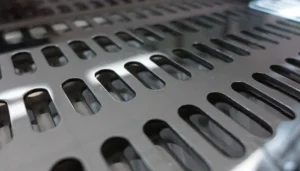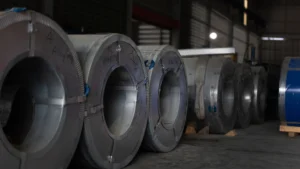Stainless Steel Plate Corrosion Test: Methods, Standards, & Results
Struggling to ensure your stainless steel will last? Material failure is costly and damages your reputation. Rigorous corrosion testing[^1] provides the certainty you need for long-term performance and reliability.
A corrosion test subjects a stainless steel plate to a controlled, corrosive environment to measure its resistance. It uses methods like salt spray or electrochemical analysis to predict real-world performance, validate material quality, and ensure fitness for a specific application.

As the Global Business Director at MFY, I've seen firsthand how crucial it is to move beyond simple specifications and truly understand how a material will behave in its intended environment. A certificate of analysis is just the beginning; the real proof is in the performance. Corrosion testing is the bridge between the two. It’s not just a box to check—it's a fundamental part of risk management and quality assurance in any serious industrial project. Let's explore the methods, standards, and results that define this essential process.
What are the common methods used for testing corrosion in stainless steel plates?
Need to test for corrosion? Choosing the wrong method can give you misleading or useless data. We use specific, proven tests tailored to the application for reliable and actionable results.
Common methods include salt spray testing (ASTM B117) for atmospheric corrosion, potentiodynamic polarization scans for electrochemical behavior, and immersion tests in specific chemical solutions to simulate harsh industrial environments for stainless steel plates.

At MFY, we view testing not as a single action, but as a diagnostic process. The method we choose depends entirely on the end-use of the stainless steel plate. I remember a project for a coastal desalination plant where the client was concerned about chloride-induced corrosion. A standard salt spray test wasn't enough to give them the confidence they needed. We had to use more advanced techniques to truly understand the material's limits and guarantee its longevity. This experience highlighted the importance of a tailored approach.
Salt Spray Testing
This is one of the most common and standardized tests, particularly for evaluating resistance to atmospheric corrosion, like you'd find in marine or de-icing salt environments. The test, governed by standards like ASTM B117, involves placing samples in a closed chamber and exposing them to a dense saltwater fog. It's an accelerated test, meaning it simulates months or years of exposure in just a few hundred hours. While excellent for quality control and comparing coatings, it's more of a qualitative check.
Electrochemical Testing
For more demanding applications, we turn to electrochemical methods like potentiodynamic polarization. This technique provides precise, quantitative data on how a material behaves. We can determine the exact potential at which pitting corrosion begins (the pitting potential[^2]), measure the corrosion rate, and understand the stability of the passive layer that gives stainless steel its protective qualities. This is the kind of deep insight that engineering contractors for chemical plants or offshore platforms demand.
| Test Method | Основная цель | Data Type |
|---|---|---|
| Salt Spray (ASTM B117) | Simulates atmospheric/marine corrosion | Qualitative (Pass/Fail) |
| Electrochemical Scan | Measures pitting & corrosion rates | Quantitative (Volts, Amps) |
| Immersion Test (ASTM G48) | Evaluates resistance to specific chemicals | Weight Loss / Pitting |
What standards are applied in stainless steel plate corrosion testing?
Confused by different testing standards? Non-compliance with recognized standards can lead to project rejection and costly disputes. Adhering to global standards like ASTM and ISO ensures universal quality.
Key international standards include ASTM G48 for pitting resistance, ASTM B117 for salt spray, and ISO 9227 for corrosion tests in artificial atmospheres. These standards ensure test results are consistent, repeatable, and globally recognized by engineers and clients.

In my role, I work with clients from Germany to Brazil, and the one thing they all have in common is a demand for quality backed by verifiable standards. Standards are the common language of global trade and engineering. They ensure that when we say a stainless steel plate has a certain level of corrosion resistance, our client in another hemisphere knows exactly what that means. At MFY, we don't just see these as rules to follow; they are our promise of quality and reliability. Adherence to these standards is a core part of our commitment to driving the global expansion of China's stainless steel supply chain.
The Role of ASTM International
ASTM provides some of the most widely used standards in our industry. They are incredibly specific and cover a vast range of scenarios. For instance, ASTM G48 is a critical test for us. It involves immersing a sample in a ferric chloride solution to determine its resistance to pitting and crevice corrosion[^3], which are two of the most insidious forms of corrosion for stainless steel. Passing this test is often a non-negotiable requirement for materials used in chemical processing and marine applications.
Understanding ISO Standards
The International Organization for Standardization (ISO) provides standards that facilitate international trade. ISO 9227, for example, is the global counterpart to ASTM B117 for salt spray tests. Aligning our testing protocols with both ASTM and ISO standards ensures our products meet the exacting requirements of discerning clients everywhere and positions MFY as a leader in quality assurance.
| Standard | Full Title | Первичное применение |
|---|---|---|
| ASTM G48 | Pitting and Crevice Corrosion Resistance of Stainless Steels | Chemical, Marine |
| ASTM B117 | Standard Practice for Operating Salt Spray (Fog) Apparatus | General Atmospheric |
| ISO 9227 | Corrosion tests in artificial atmospheres — Salt spray tests | International Trade |
How do different testing methods impact the results of stainless steel corrosion tests?
Are you getting conflicting test results? The wrong test method can mistakenly approve a poor material or reject a suitable one. The chosen method directly shapes the outcome and its relevance.
Different methods yield varied results because they simulate different corrosive mechanisms. A salt spray test measures general atmospheric corrosion resistance, while an electrochemical test provides precise data on pitting and crevice corrosion rates, offering a more detailed performance profile.

This is a critical point that I often discuss with our clients. A client building architectural panels for a building facade has very different performance needs than one constructing chemical storage tanks. The former may only need to pass a salt spray test, while the latter requires detailed electrochemical data to prevent catastrophic failure. Guiding them to the right test avoids costly assumptions and ensures the material is truly fit for purpose. It's about moving from a simple "pass/fail" to a deep understanding of material limits.
Accelerated vs. Real-Time Data
Most lab tests are accelerated, meaning they condense years of service life into days or weeks. A salt spray test is a perfect example. It tells you how a material holds up to a constant, aggressive attack. However, it doesn't always reflect the cyclical nature of real-world conditions (e.g., wet/dry cycles). Electrochemical tests, on the other hand, can provide data that helps us model and predict long-term performance with greater accuracy, even though the test itself is short.
Qualitative vs. Quantitative Outcomes
The impact on results can be broken down into two categories: qualitative and quantitative.
- Qualitative: This is observational. After a salt spray test, we look at the plate and ask, "Is there rust? How much?" It's a visual, often subjective, assessment.
- Quantitative: This is numerical. An electrochemical test gives us hard numbers: the corrosion rate in millimeters per year, or the specific voltage at which the protective passive layer breaks down. This data can be directly plugged into engineering models and lifetime prediction formulas.
| Method | Data Type | Key Result |
|---|---|---|
| Salt Spray | Qualitative | Visual confirmation of rust (Pass/Fail) |
| Electrochemical | Quantitative | Precise pitting potential (in mV) |
What are the implications of corrosion test results for stainless steel plate applications?
Wondering what the test results actually mean? Misinterpreting data can lead to premature material failure and significant financial loss. The results directly inform material selection, design, and long-term asset management.
Corrosion test results are critical for material selection, predicting the service life of a component, and setting maintenance schedules. A passing result validates a plate's suitability for a specific environment, while a failure guides engineers to select a more resilient alloy or apply protective measures.

The results of a corrosion test are where the science meets the business. For our clients, these results have direct financial implications. A positive result provides the confidence to proceed with a billion-dollar infrastructure project. A negative result, while disappointing, is invaluable because it prevents a future failure that could be ten times more costly. This is why we emphasize comprehensive testing; it's an investment in risk mitigation. For example, if a test shows a 304-grade plate fails in a high-chloride environment, the result clearly tells the client they must upgrade to 316L or even a duplex grade. This isn't an upsell; it's essential engineering guidance that protects their investment.
Informing Material Grade Selection
The most immediate implication is on material selection. The test data provides a clear, evidence-based reason to choose one grade over another. It moves the conversation from price per ton to total cost of ownership, which is a much more valuable metric for our clients.
Predicting Service Life and Maintenance
For asset owners, knowing how long a component will last is crucial for budgeting and planning. Corrosion test data can be used in models to predict the service life of a stainless steel plate in a given environment. This also helps in establishing a proactive maintenance schedule, such as determining how often a storage tank needs to be inspected for pitting.
Quality Control and Batch Validation
On the production side, we use corrosion testing for quality control. It allows us to validate that each batch of stainless steel plates we produce meets the required performance standards. This consistency is a cornerstone of the MFY brand and a key reason our clients trust us for their critical projects.
What recommendations can be made based on the outcomes of stainless steel corrosion tests?
The test is done, so what's next? A technical report is useless without clear, actionable steps. We provide practical recommendations to optimize your project for longevity and performance.
Based on test outcomes, recommendations can include selecting a higher-grade alloy (e.g., 316L over 304), modifying the design to eliminate crevices, applying surface treatments like passivation, or establishing a specific cleaning protocol to extend the material's service life.

Our job at MFY doesn't end with delivering a plate and a test report. We see ourselves as partners in our clients' success. We help them interpret the data and turn it into a concrete action plan. This approach transforms a simple transaction into a long-term relationship built on trust and shared expertise. It’s about ensuring the client not only buys the right material but also uses it in a way that maximizes its value and lifespan. This focus on service is central to our vision of becoming the leading international trade brand in China’s stainless steel industry.
Material and Design Adjustments
The most common recommendations fall into two categories: changing the material or changing the design. If a test shows pitting, the solution might be a material upgrade. If it shows crevice corrosion, the recommendation might be to redesign a joint to eliminate the tight gap where corrosive agents can accumulate.
Surface Treatments and Maintenance
Sometimes, the base material is appropriate, but it needs help. We might recommend a passivation treatment to enhance the natural protective oxide layer on the stainless steel. For other applications, the recommendation could be a simple but crucial maintenance plan, outlining a regular washing schedule to remove corrosive deposits.
| Test Outcome | Possible Recommendation |
|---|---|
| Pitting Detected in Chloride Test | Upgrade from 304 to 316L or Duplex grade. |
| Crevice Corrosion at Welds | Ensure welds are smooth and post-weld cleaned. |
| General Surface Discoloration | Implement a regular cleaning/maintenance schedule. |
| Marginal Pass | Consider passivation to improve the passive layer. |
Заключение
Corrosion testing is not just a quality check; it is a strategic tool for risk management and asset protection. It ensures material reliability, protects investments, and drives innovation, making it a fundamental process for any successful engineering project in today's demanding global market.
У вас есть вопросы или нужна дополнительная информация?
Свяжитесь с нами, чтобы получить индивидуальную помощь и квалифицированный совет.





